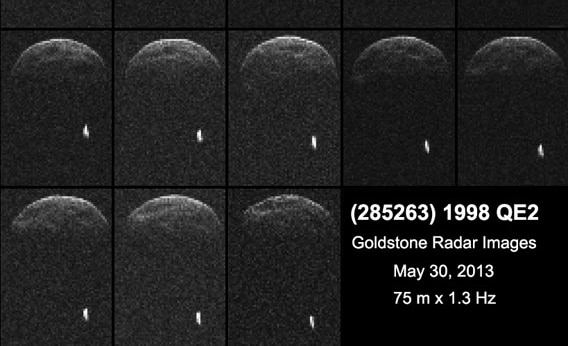Create a free profile to get unlimited access to exclusive videos, sweepstakes, and more!
Asteroid 1998 QE2 Has a Moon!

Say hello to my little rocky friend: Asteroid (285263) 1998 QE2 has a moon!
The asteroid pair is currently on a relatively near pass of Earth, sailing by us at a closest approach of just under 6 million kilometers (3.6 million miles) later Friday. Asteroids that get this close are of particular interest to astronomers, because that means we can use radio telescopes to bounce radar off them, which can lead to a better determination of their size, shape, speed and position.
Using the Goldstone telescope in California, astronomers were surprised to find that 1998 QE2 is actually a binary asteroid, a big rock being orbited by smaller one. Here’s the video of the two (the moon is the bright spot seen moving vertically over time):
Statistically, it’s not shocking that 1998 QE2 has a moon; about 16 percent of near-Earth asteroids bigger than 200 meters across have companions. The primary is about 2.7 kilometers (1.7 miles) across, as previously estimated, and the moon is about 600 meters (2,000 feet) across. More observations are planned over the next few days, including using the Arecibo radio telescope, which will provide higher-resolution data.
Mind you, the radar data is a bit weird. It’s not showing you an actual picture of the asteroid. The vertical axis is showing distance to the asteroid—if there’s a hill you’d see it poke up toward the top, and a crater would be a depression. The horizontal axis, though, is actually the velocity at which the asteroid is spinning. The faster the rock spins, the more smeared out it is left to right; one that doesn’t spin at all would look like a vertical line. I know, it’s weird, but it’s the way this kind of radar observation works.
Not only that, but we’re illuminating it with the radar pulses, so when you look at the picture or video, it’s like the radio telescope is off the top of the frame, shining down on the asteroid. Imagine holding an orange in one hand and a flashlight in the other; you’re illuminating one side, not the whole thing. Radar reflections are strongest from the point on the asteroid directly under the radar beam, so that becomes the bright edge in the image. The reflections tend to get weaker near the edge, so it fades toward the bottom, giving it that odd crescent shape.
The moon looks curiously bright in the radar imagery, but I’m not sure why; I haven’t heard any comments about this yet—that may simply be because it’s small, so we don’t see it fade as much toward its edges like we do in the bigger rock. Think of it like having all its light compressed into fewer pixels, so each pixel is brighter.
From these data we now know that the main asteroid spins about once every fours hours at the most—previously it was thought to have a 5.3-hour spin. That old estimate was based on its light curve—that is, brightness variations as it spins. Imagine a dark ball with a single white spot on it. As it spins, you’d see it get brighter every time the white spot comes into view, and that can be used to peg its rotation. It’s not always 100 percent accurate, though, as it wasn't in this case. There are several dark features on the asteroid that may be craters, but they might also be patches of material that absorb radar so they simply look darker. We should know better soon as more data come down.
The moon spins more slowly—you can see it’s not very smeared out in the radar data. It probably takes a day or so to rotate once, but the actual rate is still not well known.
The very presence of the moon is a good thing. By measuring how long it takes to go around the primary, the mass of the primary can be found using math known for centuries (the more massive the big asteroid, the faster the moon will go around it at a given distance). We also know the size of the primary, so that means we can find its density, and therefore what it’s made of (probably mostly rock). Those numbers should be coming in over the next few days.
And finally, using the radar we get the precise position and velocity of the asteroid over time, and that allows a much better determination of its orbit around the Sun. We know that 1998 QE2 is not a threat to Earth, but it’s still nice to show that more clearly.
Of all the data we’re getting on this asteroid pair, the radar is the most precious because of the treasure trove we get from it. Just by bathing it in radio light and watching for the reflection we get a better orbit for it, we see it’s a binary, and we can determine its mass and even composition… all from millions of kilometers away.
That’s pretty amazing. There’s nothing like going to an asteroid and seeing it up close—and there are plans to do that—but we can learn a lot from the safety of our home planet too. Not bad for a bunch of apes who only recently figured out how to get into space in the first place.


























